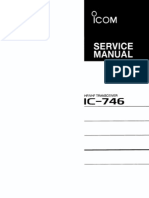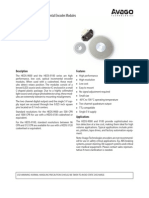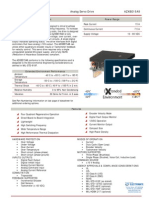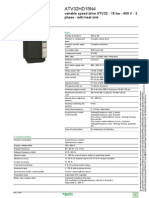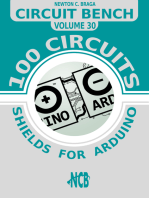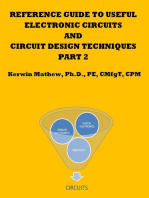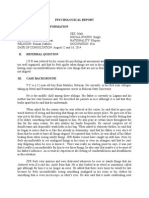Data Sheet: AEDT-9140 Series
Data Sheet: AEDT-9140 Series
Uploaded by
ehuamanibCopyright:
Available Formats
Data Sheet: AEDT-9140 Series
Data Sheet: AEDT-9140 Series
Uploaded by
ehuamanibOriginal Title
Copyright
Available Formats
Share this document
Did you find this document useful?
Is this content inappropriate?
Copyright:
Available Formats
Data Sheet: AEDT-9140 Series
Data Sheet: AEDT-9140 Series
Uploaded by
ehuamanibCopyright:
Available Formats
AEDT-9140 Series
High Temperature 115qC
Three Channel Optical Incremental Encoder Modules
100 CPR to 1000 CPR
Data Sheet
Description
The AEDT-9140 series are three channel optical incremen-
tal encoder modules. When used with a codewheel, these
low cost modules detect rotary position. Each module
consists of a lensed LED source and a detector IC enclosed
in a small plastic package. Due to a highly collimated light
source and a unique photodetector array, these modules
are extremely tolerant to mounting misalignment.
The AEDT-9140 has two channel quadrature outputs plus
a third channel index output. This index output is a 90
electrical degree high true index pulse which is generated
once for each full rotation of the codewheel.
The AEDT-9140 optical encoder is designed for use with a
codewheel which has an optical radius of 11.00 mm (0.433
inch) for 100 CPR to 1000 CPR and 11.68 mm (0.460 inch)
for 1000 CPR.
The quadrature signals and the index pulse are accessed
through ve 0.46 mm square pins located on 1.27 mm
(pitch) centers.
Features
x Two channel quadrature output with index pulse
x Resolution from 100 CPR to 1000 CPR (Cycles Per
Revolution)
x Low cost
x Easy to mount
x No signal adjustment required
x Small size
x -40qC to 115qC operating temperature
x TTL compatible
x Single 5V supply
Applications
Typical applications include:
x Printers
x Plotters
x Tape drives
x Machine tools
x Industrial and factory automation equipment.
Note: Avago Technologies encoders are not recommended for use in
safety critical applications. Eg. ABS braking systems, power steering, life
support systems and critical care medical.
2
Theory of Operation
The AEDT-9140 is an emitter/detector module. Coupled
with a codewheel, these modules translates rotary motion
of a shaft into a three-channel digital output.
As seen in Figure 1, the modules contain a single Light
Emitting Diode (LED) as its light source. The light is col-
limated into a parallel beam by means of a single poly-
carbonate lens located directly over the LED. Opposite the
emitter is the integrated detector circuit. This IC consists
of multiple sets of photodetectors and the signal process-
ing circuitry necessary to produce the digital waveforms.
The codewheel rotates between the emitter and detector,
causing the light beam to be interrupted by the pattern of
spaces and bars on the codewheel.
The photodiodes which detect these interruptions are
arranged in a pattern that corresponds to the radius and
design of the code-wheel. These detectors are also spaced
such that a light period on one pair of detectors corre-
sponds to a dark period on the adjacent pair of detectors.
The photodiode outputs are then fed through the signal
processing circuitry resulting in A, A-bar, B, B-bar, I and I-
bar. Comparators receive these signals and produce the
nal output for channels A and B. Due to this integrated
phasing technique, the digital output of channel A is
in quadrature with that of channel B (90 degrees out of
phase).
Denitions
Note: Refer to Figure 2
Cycles (N): The number of electrical cycles per revolution
(CPR). Note: CPR refers to the raw signal from encoder, that
is the cycles before 4x decode.
One Cycle (C): 360 electrical degrees (qe).
One Shaft Rotation: 360 mechanical degrees, N cycles.
Cycle Error ('C): An indication of cycle uniformity. The dier-
ence between an observed shaft angle which gives rise to
one electrical cycle, and the nominal angular increment of
1/N of a revolution.
Pulse Width (S): The number of electrical degrees that an
output is high during 1 cycle. This value is nominally
180e or 1/2 cycle.
Pulse Width Error ('P): The deviation, in electrical degrees, of
the pulse width from its ideal value of 180e.
State Width (S): The number of electrical degrees between a
transition in the output of channel A and the neighboring
transition in the output of channel B. There are 4 states per
cycle, each nominally 90e.
State Width Error ('S): The deviation, in electrical degrees, of
each state width from its ideal value of 90e.
Phase Error ('I): The deviation of the phase from its ideal
value of 90e.
Direction of Rotation: When the codewheel rotates in the
clockwise direction viewing from top of the module (di-
rection from V to G), channel A will lead channel B. If the
codewheel rotates in the opposite direction, channel B
will lead channel A.
Optical Radius (Rop): The distance from the codewheels cen-
ter of rotation to the optical center (O.C) of the encoder
module.
Index Pulse Width (Po): The number of electrical degrees that
an index is high during one full shaft rotation. This value is
nominally 90qe or 1/4 cycle.
3
Block Diagram
Output Waveforms
Figure 1.
Figure 2.
A
B
I
A
B
I
SIGNAL PROCESSING
CIRCUITRY
COMPARATORS
PHOTO
DIODES
LENS
LED
RESISTOR
EMITTER SECTION
DETECTOR SECTION
CODE
WHEEL
V
CC
CH. A
CH. B
CH. I
GND
INDEX
PROCESSING
CIRCUITRY
4
AEDT-9140 Technical Specications
Absolute Maximum Ratings
Parameter Symbol Min. Max. Units Notes
Storage Temperature T
S
-40 115 C
Operating Temperature T
A
-40 115 C
Supply Voltage V
CC
-0.5 7 Volts
Output Voltage V
O
-0.5 V
CC
Volts
Output Current per Channel, Iout I
OUT
-1.0 18 mA
Recommended Operating Conditions
Parameter Symbol Min. Typ. Max. Units Notes
Temperature T
A
-40 115 C
Supply Voltage V
CC
4.5 5.0 5.5 Volts Ripple < 100mVp-p
Load Capacitance C
L
100 pF 2.7 k pull-up
Frequency f 100 kHz Velocity (rpm) x N/60
Shaft Perpendicularity
Plus Axial Play
r 0.20
(r 0.008)
mm
(in.)
Refer to Mounting Consideration
Shaft Eccentricity
Plus Radial Play
0.04
(0.0015)
mm
(in.)
Refer to Mounting Consideration
Electrical Characteristics
Electrical characteristics over recommend operating range, typical at 25qC.
Parameter Symbol Min. Typ Max. Units Notes
Supply Current I
CC
30 57 85 mA
High Level Output Voltage V
OH
2.4 V Typ. I
OH
= -0.5 mA
Low Level Output Voltage V
OL 0.4 V Typ. I
OL
= 10 mA
Rise Time t
r
180 ns C
L
= 25 pF
R
L
= 2.7 k: pull-up
Fall Time t
f
50 ns
Note: Typical values specied at Vcc = 5.0 V and 25 C
5
Encoding Characteristics
AEDT-9140 (except B0B)
Encoding Characteristics over the recommended operating conditions and recommended mounting tolerances unless
otherwise specied.
Parameter Symbol Min. Typ. Max. Units
Cycle Error
C
3 15 e
Pulse Width Error
P
7 30 e
Logic State Width Error
S
5 30 e
Phase Error
2 15 e
Position Error
10 40 min. of arc
Index Pulse Width P
o
60 90 120 e
CH I rise after
CH B or CH A fall
-40C to + 115C t
1
10 100 1000 ns
CH I rise after
CH A or CH B rise
-40C to + 115C t
2
10 300 1000 ns
Encoding Characteristics
AEDT-9140-B0B & AEDT-9140-B00
Encoding characteristics over the recommended operating conditions and recommended mounting tolerances unless
otherwise specied.
Parameter Symbol Min. Typ. Max. Units
Cycle Error - B0B option
- B00 option
C
3
6
15
20
e
Pulse Width Error
P
7 50 e
Logic State Width Error
S
5 50 e
Phase Error
2 15 e
Position Error
10 40 min. of arc
Index Pulse Width P
o
40 90 120 e
CH I rise after
CH B or CH A fall
-40C to + 115C t
1
10 450 1500 ns
CH I rise after
CH A or CH B rise
-40C to + 115C t
2
10 250 1500 ns
6
Electrical Interface
To ensure reliable encoding performance, the AEDT-9140
three channel encoder modules require 2.7 k ( 10%)
pull-up resistors on output pins 2, 3, and 5 (Channels A, I
and B) as shown in Figure 3. These pull-up resistors should
be located as close to the encoder module as possible
(within 4 feet). Each of the three encoder module outputs
can drive a single TTL load in this conguration.
Figure 3.
Customized Solutions
Customization of codewheel CPR is possible. It has to be
based on the encoder LPI table given below.
Part Number LPI
AEDT-9140-C00 36.7
AEDT-9140-E00 73.5
AEDT-9140-F00 94
AEDT-9140-G00 132.3
AEDT-9140-H00 147
AEDT-9140-A00 183
AEDT-9140-I00 188
AEDT-9140-B0B 346
AEDT-9140-B00 367.5
CPR calculation formula:
CPR = LPI x 2 x S x ROP
25.4
Where:
CPR = Counts Per Revolution
LPI = Encoder LPI provided in the table
ROP = Encoder Optical Radius in mm
* Recommended maximum codewheel diameter should
not exceed 30mm.
Note: The customization of the codewheel method is valid from theoreti-
cal standpoint. However Avago strongly recommends a full character-
ization to be done to determine the actual performance of the encoder
with customized codewheel.
Characterization means validating the encoding performance (consist
of cycle error, pulse width error, logic state width error, phase error, po-
sition error & index pulse width, index channel rise and fall time over
the recommended operating conditions and recommended mounting
tolerances.
7
Mounting Considerations
Rop
12.60
6.30
0.50
ARTWORK
Codewheel
MOUNTING BOSS
2MM DIA.
2 PLACES
OPTICAL CENTER AXIS
GAP TYPICAL
E
G
E
T
E
R
SHAFT
CENTER
AXIS
OPTICAL
CENTER
AXIS
MOUNTING PLANE
R0.89
Recommended Screw Size: M1.6 x 0.35
Recommended Mounting Screw
Torque : 1 Lbin (0.113 Nm)
Note:
These dimensions include shaft endplay and codewheel warp. All dimension for mounting the module and codewheel should be measured with
respect to two mounting boss, as shown above.
Error Rop = 11mm Unit Notes
E
G
Gap 0.20 mm Recommend to mount the codewheel closer to the detector side
(upper side) for optimum encoder performance.
E
R
Radial 0.13 mm
E
T
Tangential 0.13 mm
8
Package Dimension
21.60
13.6
1.6
5.34
2.00
0.80
3.00
4.00
0.46 1.27
4.90
1.78
2.40
13.60
1.60
21.60
1.17
3.00
4.40
2.69
3.69
17.80
3.69
Optical Center Axis
Optical Center Axis
Optical Center Axis
TYPICAL DIMENSIONS IN MILLIMETERS
Front View
Side View
Top View
R15.50
R0.89
For product information and a complete list of distributors, please go to our web site: www.avagotech.com
Avago, Avago Technologies, and the A logo are trademarks of Avago Technologies in the United States and other countries.
Data subject to change. Copyright 2005-2009 Avago Technologies. All rights reserved.
AV02-1101EN - November 10, 2009
Ordering Information
Option AEDT-9140
Resolution Options Codewheels Optical Radius
C - 00 - 11.00 mm
E - - 11.68 mm
F -
G -
H -
A -
I -
B -
256 CPR
1000 CPR
100 CPR
200 CPR
360 CPR
400 CPR
500 CPR
512 CPR
0B
You might also like
- Emcp II+3512c CaterpillarDocument4 pagesEmcp II+3512c CaterpillarManuel Otero85% (20)
- Emcp II+3512c CaterpillarDocument4 pagesEmcp II+3512c CaterpillarManuel Otero85% (20)
- 6th Central Pay Commission Salary CalculatorDocument15 pages6th Central Pay Commission Salary Calculatorrakhonde100% (436)
- Msdac Frauscher ACS2000Document12 pagesMsdac Frauscher ACS2000Pooja Singh100% (1)
- IC-746 Service ManualDocument128 pagesIC-746 Service ManualRobert Alan JacksonNo ratings yet
- End of 2nd Semester Writing Rubric Grade 12 - (Short Writing - Functional)Document1 pageEnd of 2nd Semester Writing Rubric Grade 12 - (Short Writing - Functional)anouar_maalej3624No ratings yet
- (MADHU MANGAL PAUL) Numerical Analysis For ScientiDocument666 pages(MADHU MANGAL PAUL) Numerical Analysis For Scientipratik chakraborty77% (13)
- The Scarlet Letter - BookDocument125 pagesThe Scarlet Letter - BookDiana CavasdanNo ratings yet
- Data Sheet: AEDB-9340 SeriesDocument15 pagesData Sheet: AEDB-9340 SeriesploglNo ratings yet
- Encoder H9720Document10 pagesEncoder H9720Marco Antonio Henriquez100% (1)
- Sensor Encoder PDFDocument10 pagesSensor Encoder PDFDaniel SuarezNo ratings yet
- Quick Assembly Two and Three Channel Optical Encoders: Technical DataDocument15 pagesQuick Assembly Two and Three Channel Optical Encoders: Technical DataRodolfo OlveraNo ratings yet
- Encoder Mini h9700Document13 pagesEncoder Mini h9700Ramirez ManuelNo ratings yet
- Small Optical Encoder Modules: Technical DataDocument12 pagesSmall Optical Encoder Modules: Technical DataMario StoyanovNo ratings yet
- Avago AEDS 9621#P10 DatasheetDocument10 pagesAvago AEDS 9621#P10 DatasheettoondaemenNo ratings yet
- Data Sheet: HEDS-9730, HEDS-9731Document6 pagesData Sheet: HEDS-9730, HEDS-9731Shohag MiaNo ratings yet
- Agilent AEDS-962x For 300 LPI Ultra Small Optical Encoder ModulesDocument11 pagesAgilent AEDS-962x For 300 LPI Ultra Small Optical Encoder ModulesLucio UbelluNo ratings yet
- AV02 1867EN - DS - HEDS 9x00 - 2013 12 19Document9 pagesAV02 1867EN - DS - HEDS 9x00 - 2013 12 19Daniel Sanz MerodioNo ratings yet
- Datasheet AEAT-6600Document11 pagesDatasheet AEAT-6600ArminNo ratings yet
- AV02 3608EN DS HEDB 9100 12jun2012Document5 pagesAV02 3608EN DS HEDB 9100 12jun2012Eddy MañayNo ratings yet
- Agilent Optical EncodersDocument8 pagesAgilent Optical EncodersAla BalaNo ratings yet
- Hohner Katalog 2009 EnglischDocument62 pagesHohner Katalog 2009 Englischbradutu72No ratings yet
- Encoder White PaperDocument9 pagesEncoder White Papersaneie99No ratings yet
- AV02 4517EN - DS - AEDR 871x - 2014 06 060Document11 pagesAV02 4517EN - DS - AEDR 871x - 2014 06 060gregcooler123No ratings yet
- Obsolete: Installation Instructions Size 15 Incremental Encoder, Bulletin 845PDocument2 pagesObsolete: Installation Instructions Size 15 Incremental Encoder, Bulletin 845Ptejap314No ratings yet
- Incremental Encoder Signals - HTL (Push-Pull) or TTL (RS422)Document7 pagesIncremental Encoder Signals - HTL (Push-Pull) or TTL (RS422)Laboratorio Recife FlateckNo ratings yet
- AEAT 9000 1GSH0 Full Option Ultra Precision 17 Bit Absolute Single Turn Encoder PDFDocument8 pagesAEAT 9000 1GSH0 Full Option Ultra Precision 17 Bit Absolute Single Turn Encoder PDFNguyen Quang VinhNo ratings yet
- B106 Rotary Encoder User's ManualDocument10 pagesB106 Rotary Encoder User's ManualTan Chin LuhNo ratings yet
- SonarDocument14 pagesSonarUros SmiljanicNo ratings yet
- 26070-Test 18 Bit ADCs With An Ultrapure Sine Wave Oscillator PDFDocument5 pages26070-Test 18 Bit ADCs With An Ultrapure Sine Wave Oscillator PDFLuca CarboneNo ratings yet
- IT3401C Codeur RotatifDocument4 pagesIT3401C Codeur RotatifDejuan HuffNo ratings yet
- Data Sheet: HEDS-97EX SeriesDocument10 pagesData Sheet: HEDS-97EX SeriesИгорь БезукладниковNo ratings yet
- Raytheon R1206XXDocument70 pagesRaytheon R1206XXtyutyuNo ratings yet
- DV k584n SJDocument123 pagesDV k584n SJinformscribdNo ratings yet
- ATS692 H DatasheetDocument12 pagesATS692 H Datasheetshivani_mehrotra_8No ratings yet
- Encoder SheetDocument5 pagesEncoder SheetMuhammad Ahtisham AsifNo ratings yet
- Heds-5500 (Av02-1046en)Document13 pagesHeds-5500 (Av02-1046en)Jose CarlosNo ratings yet
- Data Sheet: HEDM-55xx/560x & HEDS-55xx/56xxDocument13 pagesData Sheet: HEDM-55xx/560x & HEDS-55xx/56xxLuiguiNo ratings yet
- WIRE LESS Land Mine Detection Robo-VehicleDocument35 pagesWIRE LESS Land Mine Detection Robo-VehicleDebashish BeheraNo ratings yet
- Heds-9100 885789Document9 pagesHeds-9100 885789cesar.cueva.ramosNo ratings yet
- Stroke Reading Cylinder and Counter: SeriesDocument44 pagesStroke Reading Cylinder and Counter: SeriesasritaipNo ratings yet
- Ds PIC30 F3010Document8 pagesDs PIC30 F3010intern08No ratings yet
- Description Power Range: Analog Servo DriveDocument8 pagesDescription Power Range: Analog Servo DriveElectromateNo ratings yet
- Absolute EncoderDocument7 pagesAbsolute EncoderMark TorresNo ratings yet
- Encoders ERHSADocument68 pagesEncoders ERHSAJuan Manuel BlasNo ratings yet
- Description Power Range: Analog Servo DriveDocument8 pagesDescription Power Range: Analog Servo DriveElectromateNo ratings yet
- EKA3 - 1 Pag.20Document30 pagesEKA3 - 1 Pag.20Razvan MaresNo ratings yet
- DC Motor With Encoder Manual (1.1 W)Document7 pagesDC Motor With Encoder Manual (1.1 W)Saad NajibNo ratings yet
- Angulation Theory PDFDocument10 pagesAngulation Theory PDFAndreyNo ratings yet
- Encoders PDFDocument6 pagesEncoders PDFFernando Xavier Guanoluisa Solano100% (1)
- A3423 Datasheet PDFDocument10 pagesA3423 Datasheet PDFRuannytha RibeiroNo ratings yet
- Renishaw Encoders RGH41 Series ReadheadDocument4 pagesRenishaw Encoders RGH41 Series ReadheadjuliangoalNo ratings yet
- Description Power Range: Analog Servo DriveDocument7 pagesDescription Power Range: Analog Servo DriveElectromateNo ratings yet
- Description Power Range: Analog Servo DriveDocument8 pagesDescription Power Range: Analog Servo DriveElectromateNo ratings yet
- Phase & Residual Overcurrent: Protection RelaysDocument6 pagesPhase & Residual Overcurrent: Protection RelaysEric Espinoza BenturaNo ratings yet
- ATV32HD15N4Document12 pagesATV32HD15N4gasm22No ratings yet
- Iraudamp3 - 120W X 6 Channel Class D Audio Power Amplifier Using IRS20124S and IRF6645Document40 pagesIraudamp3 - 120W X 6 Channel Class D Audio Power Amplifier Using IRS20124S and IRF6645Anonymous R0s4q9X8No ratings yet
- Report - RFid Based Security SystemDocument46 pagesReport - RFid Based Security SystemDhaval Rana50% (6)
- Imprimir Datasheet 1Document14 pagesImprimir Datasheet 1Randy Siancas VelezNo ratings yet
- Isolation Circuits For General Purpose Analog Applications: ContentsDocument10 pagesIsolation Circuits For General Purpose Analog Applications: ContentsNarendra BholeNo ratings yet
- M/V™ Series Servo Drive: Description Power RangeDocument11 pagesM/V™ Series Servo Drive: Description Power RangeElectromateNo ratings yet
- Analog Dialogue, Volume 48, Number 1: Analog Dialogue, #13From EverandAnalog Dialogue, Volume 48, Number 1: Analog Dialogue, #13Rating: 4 out of 5 stars4/5 (1)
- Reference Guide To Useful Electronic Circuits And Circuit Design Techniques - Part 1From EverandReference Guide To Useful Electronic Circuits And Circuit Design Techniques - Part 1Rating: 2.5 out of 5 stars2.5/5 (3)
- Reference Guide To Useful Electronic Circuits And Circuit Design Techniques - Part 2From EverandReference Guide To Useful Electronic Circuits And Circuit Design Techniques - Part 2No ratings yet
- Hybex Microsample Incubator: Choice of Internal BlocksDocument1 pageHybex Microsample Incubator: Choice of Internal BlocksehuamanibNo ratings yet
- Temperature Calibration For Hybex With EZ Zone ControllerDocument2 pagesTemperature Calibration For Hybex With EZ Zone ControllerehuamanibNo ratings yet
- Ox Ygen System Safety: ScopeDocument4 pagesOx Ygen System Safety: ScopeINDRAJIT SAONo ratings yet
- Digi Edgeport/1, RS 232 Converter (3AUA0000050177) Not Working in USB 3.0 PortsDocument1 pageDigi Edgeport/1, RS 232 Converter (3AUA0000050177) Not Working in USB 3.0 PortsehuamanibNo ratings yet
- MS 02 484 PDFDocument12 pagesMS 02 484 PDFehuamanibNo ratings yet
- Data FTP PLC FBs Manual Manual 1 Hardware Chapter 6 PDFDocument3 pagesData FTP PLC FBs Manual Manual 1 Hardware Chapter 6 PDFsajjad aliNo ratings yet
- MS 02 484 PDFDocument12 pagesMS 02 484 PDFehuamanibNo ratings yet
- Oxigen Generator Nordic O60-3-P PDFDocument2 pagesOxigen Generator Nordic O60-3-P PDFehuamanibNo ratings yet
- DW Operating and Maintenance ManualDocument31 pagesDW Operating and Maintenance Manualehuamanib100% (1)
- 2v3b High Pressure Oxygen CompressorDocument2 pages2v3b High Pressure Oxygen CompressorwgonzalesmNo ratings yet
- Load Sharing Module - PWM OutputDocument34 pagesLoad Sharing Module - PWM OutputehuamanibNo ratings yet
- Maximal Safe Set Computation For Pressure Swing Adsorption ProcessesDocument13 pagesMaximal Safe Set Computation For Pressure Swing Adsorption ProcessesehuamanibNo ratings yet
- DASL130 C Course Week 1Document10 pagesDASL130 C Course Week 1ehuamanibNo ratings yet
- William Golding - Lord of The FliesDocument16 pagesWilliam Golding - Lord of The Fliesonutchka8479100% (1)
- Koehn, Glen (2012) The Archer and Aristotle' Doctrine of The Mean PDFDocument13 pagesKoehn, Glen (2012) The Archer and Aristotle' Doctrine of The Mean PDFEleder IruzkinNo ratings yet
- Cultural CompetenceDocument7 pagesCultural CompetenceRadoslav Baya CorlijaNo ratings yet
- Syllabus BC547 SufferingDocument7 pagesSyllabus BC547 SufferingdonjazonNo ratings yet
- PART 4 - First Language AcquisitionDocument16 pagesPART 4 - First Language Acquisitionjerry nikeNo ratings yet
- Sentence StructuresDocument6 pagesSentence StructurestrandinhgiabaoNo ratings yet
- Swajaldhara GuidelinesDocument9 pagesSwajaldhara GuidelinesSridhar AnanthaNo ratings yet
- CNCDocument63 pagesCNCSahil Bangia100% (1)
- Albert Einstein 1Document2 pagesAlbert Einstein 1Joy Mazo FaderagaoNo ratings yet
- GCSE Questions On VECTORS:, in Terms of A and BDocument7 pagesGCSE Questions On VECTORS:, in Terms of A and BSkyNo ratings yet
- Learning Through StoriesDocument10 pagesLearning Through StoriesGugum Gumelar Jr.No ratings yet
- The Seabury TowndanceDocument58 pagesThe Seabury TowndanceNathanNo ratings yet
- Erik Ringmar, Thinking Men and Ideal BetrayedDocument30 pagesErik Ringmar, Thinking Men and Ideal BetrayedErik RingmarNo ratings yet
- People V MolinaDocument3 pagesPeople V MolinaJc IsidroNo ratings yet
- Proclamation Announcement For The WORLD SERVICE AUTHORITYDocument4 pagesProclamation Announcement For The WORLD SERVICE AUTHORITY:Lawiy-Zodok:Shamu:-ElNo ratings yet
- Emmy Van Deurzen - Martin Adams - Skills in Existential Counselling & Psychotherapy (2016, Sage) - Libgen - LiDocument8 pagesEmmy Van Deurzen - Martin Adams - Skills in Existential Counselling & Psychotherapy (2016, Sage) - Libgen - LiJames BarnesNo ratings yet
- Learning Activity #4 ELED 21Document1 pageLearning Activity #4 ELED 21Jade DolorNo ratings yet
- Semeia 65, Orality and Textuality in Early Christian LiteratureDocument228 pagesSemeia 65, Orality and Textuality in Early Christian Literaturee.masanyalazi80% (5)
- Wake in Fright Movie AnalysisDocument2 pagesWake in Fright Movie AnalysislaurenNo ratings yet
- Student Guide JKM Dis 2013Document100 pagesStudent Guide JKM Dis 2013SaifAdamz'sNo ratings yet
- Developing Effective Communication Skills - SeemaDocument31 pagesDeveloping Effective Communication Skills - SeemaRamanujam O SNo ratings yet
- BoundaryGames V5Document9 pagesBoundaryGames V5Tesh McGillicutty100% (3)
- Brandon Luna Rodriguez - Resume - Brandon Luna Rodriguez 2Document2 pagesBrandon Luna Rodriguez - Resume - Brandon Luna Rodriguez 2api-409519367No ratings yet
- Practical Research 2 12 q1 Mod7finalcorrectedDocument32 pagesPractical Research 2 12 q1 Mod7finalcorrectedEster Rodulfa100% (1)
- Finding "Face" in The Preference Structures Of: Talk-in-Interacti0n Gene H. LernerDocument19 pagesFinding "Face" in The Preference Structures Of: Talk-in-Interacti0n Gene H. LernerUmiakiNo ratings yet
- Modeling in Scientific Research - Process of Science - VisionlearningDocument15 pagesModeling in Scientific Research - Process of Science - VisionlearningkumarNo ratings yet
- Case Study For OCDDocument10 pagesCase Study For OCDrowwwlizNo ratings yet



